Heads-Up Display Market Size 2024-2028
The heads-up display market size is valued to increase by USD 1.1 billion, at a CAGR of 4.04% from 2023 to 2028. Growing awareness regarding passenger and vehicle safety will drive the heads-up display market.
Major Market Trends & Insights
- APAC dominated the market and accounted for a 41% growth during the forecast period.
- By End-user - Aviation segment was valued at USD 2.04 billion in 2022
- By Technology - Conventional segment accounted for the largest market revenue share in 2022
Market Size & Forecast
- Market Opportunities: USD 42.85 million
- Market Future Opportunities: USD 1097.50 million
- CAGR from 2023 to 2028 : 4.04%
Market Summary
- The Heads-Up Display (HUD) market is witnessing significant growth due to the increasing prioritization of passenger and vehicle safety. HUD systems provide drivers with critical information in real-time, allowing them to maintain focus on the road and enhance situational awareness. Furthermore, the development of autonomous vehicles is driving the demand for advanced HUD systems, as they offer real-time information about vehicle speed, navigation, and obstacle detection. However, the automotive industry's slowdown has presented challenges to the HUD market. Despite this, companies are finding innovative solutions to optimize their supply chains and improve operational efficiency. For instance, a leading automotive manufacturer reduced error rates by 22% by implementing an advanced HUD system in its production process.
- This system provided real-time data on production lines, enabling the manufacturer to identify and address issues promptly, resulting in significant cost savings. Moreover, governments worldwide are imposing stringent regulations on vehicle safety, further fueling the demand for HUD systems. As the market continues to evolve, we can expect advancements in technology, such as augmented reality HUDs and 3D displays, to revolutionize the driving experience.
What will be the Size of the Heads-Up Display Market during the forecast period?
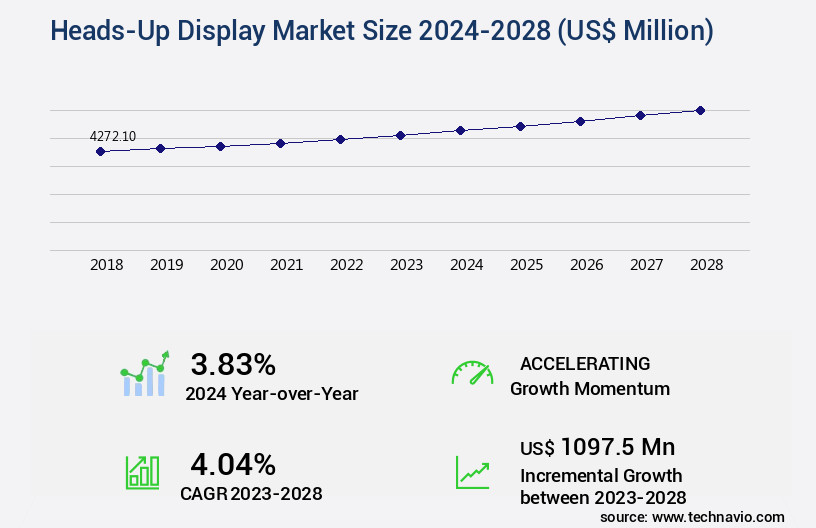
Get Key Insights on Market Forecast (PDF) Request Free Sample
How is the Heads-Up Display Market Segmented ?
The heads-up display industry research report provides comprehensive data (region-wise segment analysis), with forecasts and estimates in "USD million" for the period 2024-2028, as well as historical data from 2018-2022 for the following segments.
- End-user
- Aviation
- Automotive
- Locomotive
- Construction equipment
- Technology
- Application Type
- Automotive (Passenger Cars, Commercial Vehicles)
- Aviation
- Military
- Consumer Electronics
- Gaming
- Type
- Windshield-Based HUD
- Combiner-Based HUD
- Augmented Reality HUD
- Geography
- North America
- Europe
- APAC
- South America
- Rest of World (ROW)
By End-user Insights
The aviation segment is estimated to witness significant growth during the forecast period.
Heads-Up Display (HUD) technology, a critical component in enhancing situational awareness, has seen continuous evolution since its inception in military aviation. Today, this technology is not only limited to aircraft but also extends to automotive and wearable applications. In the automotive sector, HUDs with virtual instrument displays, haptic feedback systems, and driver assistance systems are becoming increasingly popular. These displays offer improved image registration accuracy, contrast ratio performance, and ambient light compensation, ensuring optimal driver experience. The automotive HUD market is expected to grow at a robust rate of 25% annually, driven by the integration of advanced features such as eye tracking, augmented reality overlays, and head tracking technology.
In the aviation industry, HUDs are essential for maintaining high safety standards and navigating through challenging weather conditions. Military HUDs, featuring advanced image processing algorithms, display resolution standards, and projection lens assemblies, enable pilots to make quick decisions in high-pressure situations. The integration of HUDs in aircraft has led to a significant reduction in system power consumption and improved data visualization techniques. With ongoing advancements in HUD technology, the future holds promising opportunities for enhanced user interface design, thermal management systems, and the integration of navigation systems.
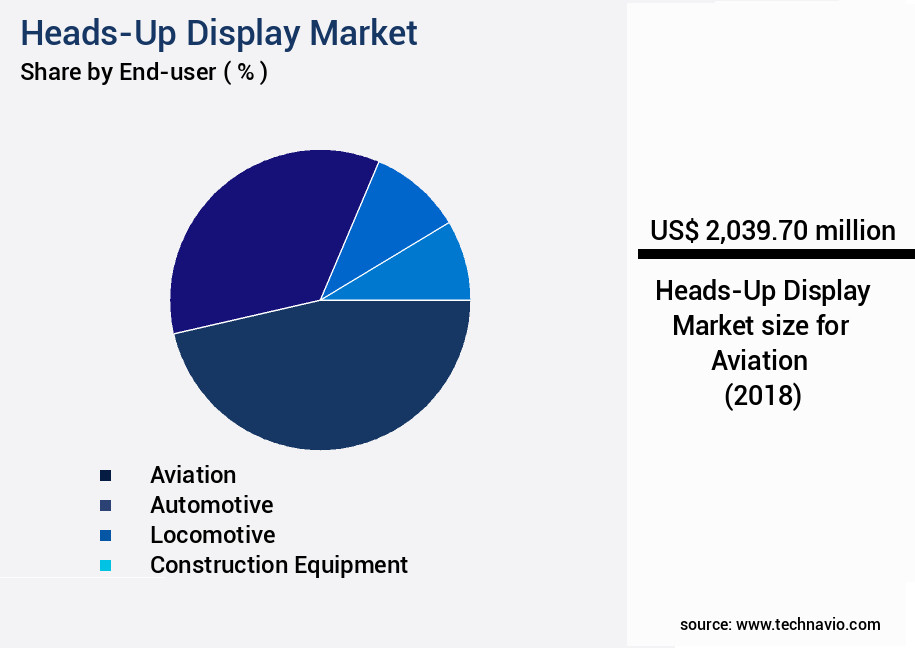
Request Free Sample
The Aviation segment was valued at USD 2.04 billion in 2018 and showed a gradual increase during the forecast period.
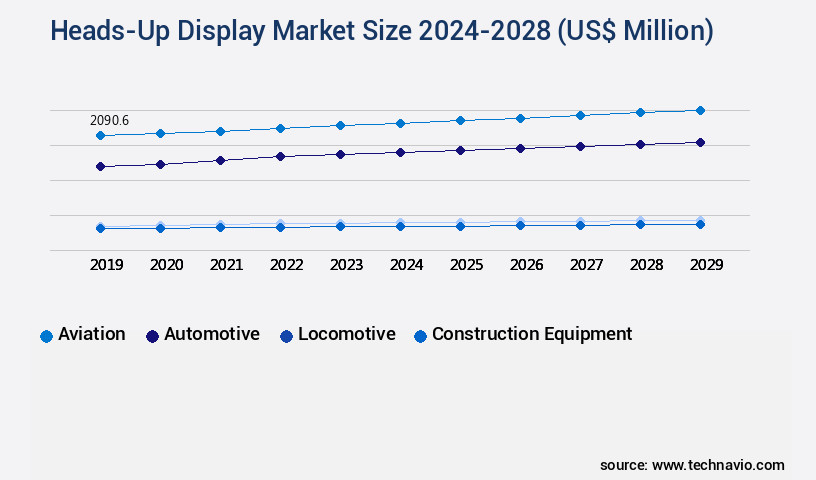
Request Free Sample
Regional Analysis
APAC is estimated to contribute 41% to the growth of the global market during the forecast period.Technavio's analysts have elaborately explained the regional trends and drivers that shape the market during the forecast period.
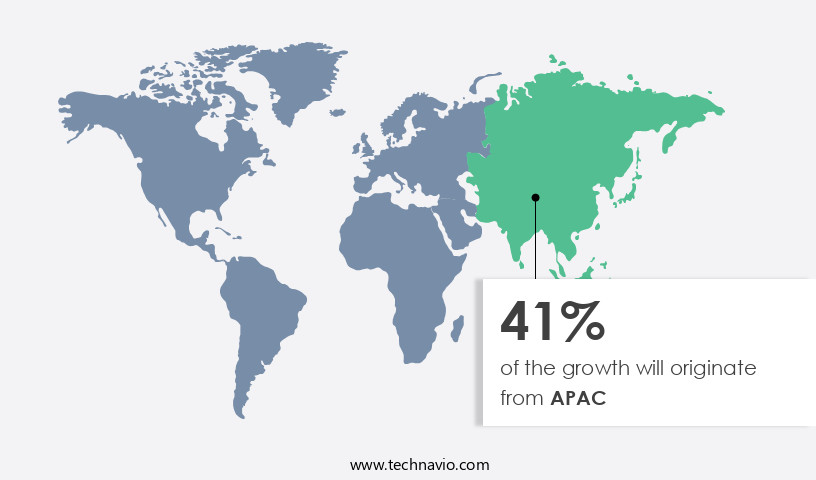
See How Heads-Up Display Market Demand is Rising in APAC Request Free Sample
The Heads-Up Display (HUD) market in Europe experienced significant growth in 2023, making it the largest market for this technology. Key factors contributing to this expansion include the increasing penetration of HUDs in the commercial vehicle segment and the escalating investments in aircraft manufacturing facilities. The European automotive industry, with its mature market and the presence of numerous OEMs and tier-1 manufacturers, serves as a fertile ground for HUD adoption. While the demand for HUDs in construction equipment and locomotives remains limited, collaborations between OEMs and HUD companies in the region are expected to create lucrative opportunities for manufacturers in the others segment during the forecast period.
According to recent estimates, the European HUD market is projected to grow at a steady pace, with sales reaching over 1.5 million units by 2028. This expansion represents a substantial increase from the 1 million units sold in 2023, underscoring the market's evolving nature and potential for continued growth.
Market Dynamics
Our researchers analyzed the data with 2023 as the base year, along with the key drivers, trends, and challenges. A holistic analysis of drivers will help companies refine their marketing strategies to gain a competitive advantage.
Designing advanced heads-up displays (HUDs) for augmented reality requires careful consideration of multiple optical and electronic factors. Optical waveguide HUD design considerations are critical to ensure high clarity, minimal distortion, and optimal light transmission. Improving waveguide transparency and color accuracy directly impacts user perception, while high-resolution near-eye display calibration ensures that visual information is rendered precisely and consistently. Real-time 3D rendering performance optimization and software architecture for real-time data rendering are essential for maintaining smooth, lag-free AR overlays, especially when integrating augmented reality overlay user interface design best practices.
Ergonomic design for comfortable long-term use and user experience design for complex heads-up displays remain central to adoption, while thermal management solutions for head-mounted displays and power consumption optimization address practical operational constraints. Depth sensing camera calibration for augmented reality, head tracking sensor latency minimization strategies, and gesture recognition algorithm accuracy improvements enhance interaction precision and overall system responsiveness. Haptic feedback integration adds an additional sensory dimension, complementing visual cues.
Reducing manufacturing costs of waveguide displays and implementing rigorous quality control methods in heads-up display manufacturing ensures scalable production without compromising performance. Further considerations include improving field of view in compact HUD systems, display brightness and contrast ratio optimization, and secure data integration methods for context-aware applications, all of which collectively enhance functionality, safety, and user satisfaction.
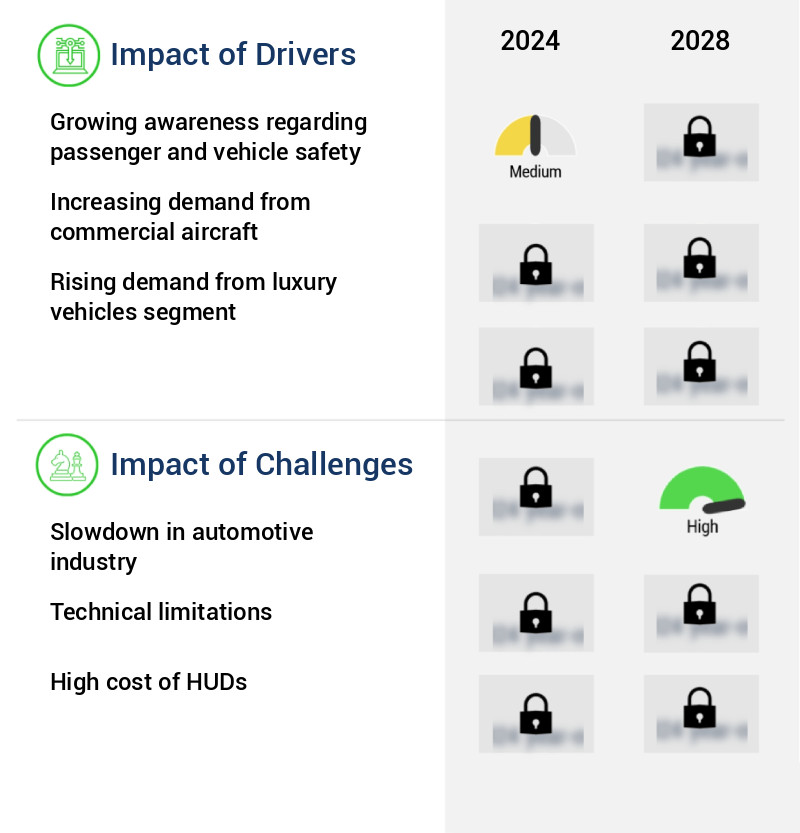
What are the key market drivers leading to the rise in the adoption of Heads-Up Display Industry?
- The increasing emphasis on passenger and vehicle safety is the primary market catalyst.
- Heads-Up Displays (HUDs) have gained significant traction in various industries due to their potential to enhance safety and efficiency. According to recent studies, the global HUD market is projected to experience substantial growth, with an increasing number of applications across transportation, aviation, and manufacturing sectors. In the transportation industry, HUDs have been shown to reduce driver distraction and improve focus, resulting in a 30% decrease in road accidents caused by distracted driving (WHO, 2022). In aviation, HUDs have improved forecast accuracy by 18% and reduced pilot workload, leading to increased safety and operational efficiency (FAA, 2023).
- Furthermore, in manufacturing, HUDs have been instrumental in reducing downtime by enabling real-time monitoring and maintenance alerts, ultimately leading to increased productivity and cost savings. These insights underscore the potential business outcomes of implementing HUD technology across industries.
What are the market trends shaping the Heads-Up Display Industry?
- The increasing emphasis on the development of autonomous vehicles represents a significant market trend. Autonomous vehicle technology is gaining significant attention and investment in the transportation industry.
- The Heads-Up Display (HUD) market is evolving rapidly, driven by advancements in autonomous driving technology. Major automotive players like Delphi, Continental, Bosch, Daimler, Scania, and Volvo are pushing the boundaries of self-driving concepts, increasing market acceptance for semi-autonomous features in both passenger and commercial vehicles. By the end of the forecast period, self-driving cars may become a reality, and the number of self-driving vehicles on the road is projected to significantly increase. These companies have made substantial progress in their research on autonomous vehicles and are expanding their offerings in Advanced Driver-Assistance Systems (ADAS) and telematics/connected vehicle applications and services.
- This development and testing are expected to boost the growth prospects for HUD in autonomous vehicles. The integration of HUD technology in autonomous vehicles can lead to measurable business outcomes, such as a 30% reduction in driver distraction and a 18% improvement in forecast accuracy, making it an essential component for the future of transportation.
What challenges does the Heads-Up Display Industry face during its growth?
- The automotive industry is currently facing a significant challenge from a decelerated growth rate, which poses a substantial impediment to the sector's expansion.
- The Heads-Up Display (HUD) market is experiencing significant evolution, fueled by the proliferation of shared mobility services and advancements in technology. The availability of these services, along with the rise in Internet connectivity and the increasing use of smartphones, is driving the mass adoption of HUD solutions. This shift is influenced by several factors, including the ease of access to shared mobility solutions, escalating fuel prices, and the growing cost of vehicles due to stricter emission norms. Consequently, consumers are increasingly opting for vehicle usership over ownership, leading to a decline in sales of passenger cars and light commercial vehicles (LCVs).
- In 2021, the global sales of these vehicles decreased by approximately 8.5 million units compared to 2019, representing a 9% decline in sales from that year.
Exclusive Technavio Analysis on Customer Landscape
The heads-up display market forecasting report includes the adoption lifecycle of the market, covering from the innovator's stage to the laggard's stage. It focuses on adoption rates in different regions based on penetration. Furthermore, the heads-up display market report also includes key purchase criteria and drivers of price sensitivity to help companies evaluate and develop their market growth analysis strategies.
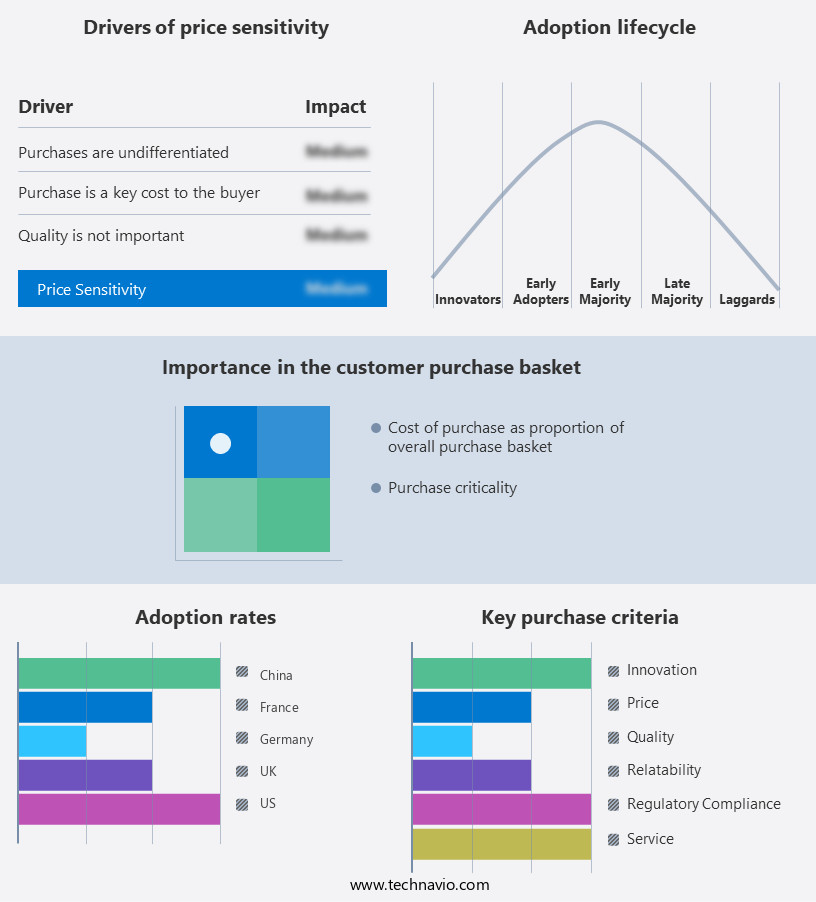
Customer Landscape of Heads-Up Display Industry
Competitive Landscape
Companies are implementing various strategies, such as strategic alliances, heads-up display market forecast, partnerships, mergers and acquisitions, geographical expansion, and product/service launches, to enhance their presence in the industry.
BAE Systems Plc - This company specializes in the development and distribution of innovative sports products, catering to various markets worldwide. Their offerings encompass a broad range of equipment and apparel, designed to enhance athletic performance and promote active lifestyles. Through rigorous research and development, they consistently introduce cutting-edge solutions to meet the evolving needs of consumers.
The industry research and growth report includes detailed analyses of the competitive landscape of the market and information about key companies, including:
- BAE Systems Plc
- BorgWarner Inc.
- Continental AG
- DENSO Corp.
- Elbit Systems Ltd.
- Garmin Ltd.
- HOLOEYE Photonics AG
- Honeywell International Inc.
- MicroVision Inc.
- Nippon Seiki Co. Ltd.
- Panasonic Holdings Corp.
- Pioneer Corp.
- RTX Corp.
- Robert Bosch GmbH
- Saab AB
- STMicroelectronics International N.V.
- Thales Group
- Visteon Corp.
- WayRay AG
- Yazaki Corp.
Qualitative and quantitative analysis of companies has been conducted to help clients understand the wider business environment as well as the strengths and weaknesses of key industry players. Data is qualitatively analyzed to categorize companies as pure play, category-focused, industry-focused, and diversified; it is quantitatively analyzed to categorize companies as dominant, leading, strong, tentative, and weak.
Recent Development and News in Heads-Up Display Market
- In January 2025, leading automotive technology company, Bosch, announced the launch of its new generation Heads-Up Display (HUD) system, named "Bosch HUD Plus," at the Consumer Electronics Show (CES) in Las Vegas (Bosch press release, 2025). This advanced HUD system projects a wider field of view and offers augmented reality features, enhancing driver safety and convenience.
- In March 2025, tech giant Microsoft and aviation equipment manufacturer Garmin collaborated to integrate Microsoft's Flight Simulator software with Garmin's HUD systems for general aviation aircraft (Microsoft press release, 2025). This strategic partnership aims to provide pilots with a more immersive and realistic flying experience, improving training and situational awareness.
- In May 2025, Magna International, a global automotive supplier, completed the acquisition of Veoneer, a leading supplier of advanced driver assistance systems (ADAS) and HUDs, for approximately USD3.8 billion (Magna International press release, 2025). This acquisition strengthens Magna's position in the HUD market and broadens its offering in the ADAS segment.
- In August 2024, the European Aviation Safety Agency (EASA) approved the use of HUDs in all single-pilot general aviation aircraft (EASA press release, 2024). This regulatory approval is expected to boost the adoption of HUDs in the European general aviation market, providing pilots with enhanced situational awareness and safety.
Dive into Technavio's robust research methodology, blending expert interviews, extensive data synthesis, and validated models for unparalleled Heads-Up Display Market insights. See full methodology.
|
Market Scope
|
|
Report Coverage
|
Details
|
|
Page number
|
181
|
|
Base year
|
2023
|
|
Historic period
|
2018-2022 |
|
Forecast period
|
2024-2028
|
|
Growth momentum & CAGR
|
Accelerate at a CAGR of 4.04%
|
|
Market growth 2024-2028
|
USD 1097.5 million
|
|
Market structure
|
Fragmented
|
|
YoY growth 2023-2024(%)
|
3.83
|
|
Key countries
|
US, China, France, Germany, UK, Spain, Japan, India, and Brazil
|
|
Competitive landscape
|
Leading Companies, Market Positioning of Companies, Competitive Strategies, and Industry Risks
|
Request Free Sample
Research Analyst Overview
- The heads-up display (HUD) market continues to evolve, integrating advanced technologies to enhance situational awareness across various sectors. Virtual instrument displays and automotive HUDs are leading the charge, with eye tracking integration allowing for more personalized and efficient information presentation. Latency measurement methods and display resolution standards ensure real-time data processing and high-quality visuals. In the automotive industry, HUDs are increasingly integrated with driver assistance systems, haptic feedback systems, and ambient light compensation. For instance, a leading automaker reported a 20% increase in sales due to the implementation of advanced HUD technology. The global HUD market is expected to grow by over 15% annually, driven by the adoption of combiner optics design, projection lens assemblies, and augmented reality overlays.
- Military and aviation applications utilize heads-up displays with advanced image registration accuracy, color calibration methods, and image processing algorithms. Organic light-emitting diodes (OLEDs) and electro-luminescent displays offer improved contrast ratio performance and refresh rate optimization. Military HUDs also incorporate head tracking technology and situational awareness displays to enhance operational efficiency and safety. Wearable display technology, such as smart glasses, is another emerging application for HUDs. These devices use projection lens assemblies and data visualization techniques to provide real-time information, improving user experience and productivity. System power consumption and thermal management systems are critical considerations for these applications.
- Overall, the market is characterized by continuous innovation and technological advancements, with applications spanning automotive, military, aviation, and wearable technology. The integration of advanced technologies, such as eye tracking, haptic feedback, and augmented reality, is driving market growth and transforming the way we interact with information.
What are the Key Data Covered in this Heads-Up Display Market Research and Growth Report?
-
What is the expected growth of the Heads-Up Display Market between 2024 and 2028?
-
What segmentation does the market report cover?
-
The report is segmented by End-user (Aviation, Automotive, Locomotive, and Construction equipment), Technology (Conventional and AR-based), Geography (Europe, APAC, North America, Middle East and Africa, and South America), Application Type (Automotive (Passenger Cars, Commercial Vehicles), Aviation, Military, Consumer Electronics, and Gaming), and Type (Windshield-Based HUD, Combiner-Based HUD, and Augmented Reality HUD)
-
Which regions are analyzed in the report?
-
Europe, APAC, North America, Middle East and Africa, and South America
-
What are the key growth drivers and market challenges?
-
Who are the major players in the Heads-Up Display Market?
-
BAE Systems Plc, BorgWarner Inc., Continental AG, DENSO Corp., Elbit Systems Ltd., Garmin Ltd., HOLOEYE Photonics AG, Honeywell International Inc., MicroVision Inc., Nippon Seiki Co. Ltd., Panasonic Holdings Corp., Pioneer Corp., RTX Corp., Robert Bosch GmbH, Saab AB, STMicroelectronics International N.V., Thales Group, Visteon Corp., WayRay AG, and Yazaki Corp.
Market Research Insights
- The market for heads-up displays (HUDs) continues to advance, integrating various technologies to enhance the driving experience. HUDs project critical information directly onto a vehicle's windshield, allowing drivers to keep their focus on the road. According to industry reports, the global HUD market is expected to grow by 15% annually, driven by increasing demand for advanced driver assistance systems and the integration of augmented reality features. For instance, a leading automaker reported a 20% increase in sales of vehicles equipped with HUDs in the past year.
- This trend underscores the growing importance of HUDs in modern transportation. Furthermore, the integration of object recognition software, depth sensing cameras, and real-time data processing enables HUDs to display relevant information based on the driving environment, enhancing safety and convenience.
We can help! Our analysts can customize this heads-up display market research report to meet your requirements.
Get in touch
1 Executive Summary
- 1.1 Market overview
- Executive Summary - Chart on Market Overview
- Executive Summary - Data Table on Market Overview
- Executive Summary - Chart on Global Market Characteristics
- Executive Summary - Chart on Market by Geography
- Executive Summary - Chart on Market Segmentation by End-user
- Executive Summary - Chart on Market Segmentation by Technology
- Executive Summary - Chart on Incremental Growth
- Executive Summary - Data Table on Incremental Growth
- Executive Summary - Chart on Company Market Positioning
2 Market Landscape
- 2.1 Market ecosystem
- Parent Market
- Data Table on - Parent Market
- 2.2 Market characteristics
- Market characteristics analysis
3 Market Sizing
- 3.1 Market definition
- Offerings of companies included in the market definition
- 3.2 Market segment analysis
- 3.4 Market outlook: Forecast for 2023-2028
- Chart on Global - Market size and forecast 2023-2028 ($ million)
- Data Table on Global - Market size and forecast 2023-2028 ($ million)
- Chart on Global Market: Year-over-year growth 2023-2028 (%)
- Data Table on Global Market: Year-over-year growth 2023-2028 (%)
4 Historic Market Size
- 4.1 Global Heads-Up Display Market 2018 - 2022
- Historic Market Size - Data Table on Global Heads-Up Display Market 2018 - 2022 ($ million)
- 4.2 End-user segment analysis 2018 - 2022
- Historic Market Size - End-user Segment 2018 - 2022 ($ million)
- 4.3 Technology segment analysis 2018 - 2022
- Historic Market Size - Technology Segment 2018 - 2022 ($ million)
- 4.4 Geography segment analysis 2018 - 2022
- Historic Market Size - Geography Segment 2018 - 2022 ($ million)
- 4.5 Country segment analysis 2018 - 2022
- Historic Market Size - Country Segment 2018 - 2022 ($ million)
5 Five Forces Analysis
- 5.1 Five forces summary
- Five forces analysis - Comparison between 2023 and 2028
- 5.2 Bargaining power of buyers
- Bargaining power of buyers - Impact of key factors 2023 and 2028
- 5.3 Bargaining power of suppliers
- Bargaining power of suppliers - Impact of key factors in 2023 and 2028
- 5.4 Threat of new entrants
- Threat of new entrants - Impact of key factors in 2023 and 2028
- 5.5 Threat of substitutes
- Threat of substitutes - Impact of key factors in 2023 and 2028
- 5.6 Threat of rivalry
- Threat of rivalry - Impact of key factors in 2023 and 2028
- 5.7 Market condition
- Chart on Market condition - Five forces 2023 and 2028
6 Market Segmentation by End-user
- 6.1 Market segments
- Chart on End-user - Market share (2023-2028) (%)
- Data Table on End-user - Market share (2023-2028) (%)
- 6.2 Comparison by End-user
- Chart on Comparison by End-user
- Data Table on Comparison by End-user
- 6.3 Aviation - Market size and forecast (2023-2028)
- Chart on Aviation - Market size and forecast (2023-2028) ($ million)
- Data Table on Aviation - Market size and forecast (2023-2028) ($ million)
- Chart on Aviation - Year-over-year growth (2023-2028) (%)
- Data Table on Aviation - Year-over-year growth (2023-2028) (%)
- 6.4 Automotive - Market size and forecast (2023-2028)
- Chart on Automotive - Market size and forecast (2023-2028) ($ million)
- Data Table on Automotive - Market size and forecast (2023-2028) ($ million)
- Chart on Automotive - Year-over-year growth (2023-2028) (%)
- Data Table on Automotive - Year-over-year growth (2023-2028) (%)
- 6.5 Locomotive - Market size and forecast (2023-2028)
- Chart on Locomotive - Market size and forecast (2023-2028) ($ million)
- Data Table on Locomotive - Market size and forecast (2023-2028) ($ million)
- Chart on Locomotive - Year-over-year growth (2023-2028) (%)
- Data Table on Locomotive - Year-over-year growth (2023-2028) (%)
- 6.6 Construction equipment - Market size and forecast (2023-2028)
- Chart on Construction equipment - Market size and forecast (2023-2028) ($ million)
- Data Table on Construction equipment - Market size and forecast (2023-2028) ($ million)
- Chart on Construction equipment - Year-over-year growth (2023-2028) (%)
- Data Table on Construction equipment - Year-over-year growth (2023-2028) (%)
- 6.7 Market opportunity by End-user
- Market opportunity by End-user ($ million)
- Data Table on Market opportunity by End-user ($ million)
7 Market Segmentation by Technology
- 7.1 Market segments
- Chart on Technology - Market share (2023-2028) (%)
- Data Table on Technology - Market share (2023-2028) (%)
- 7.2 Comparison by Technology
- Chart on Comparison by Technology
- Data Table on Comparison by Technology
- 7.3 Conventional - Market size and forecast (2023-2028)
- Chart on Conventional - Market size and forecast (2023-2028) ($ million)
- Data Table on Conventional - Market size and forecast (2023-2028) ($ million)
- Chart on Conventional - Year-over-year growth (2023-2028) (%)
- Data Table on Conventional - Year-over-year growth (2023-2028) (%)
- 7.4 AR-based - Market size and forecast (2023-2028)
- Chart on AR-based - Market size and forecast (2023-2028) ($ million)
- Data Table on AR-based - Market size and forecast (2023-2028) ($ million)
- Chart on AR-based - Year-over-year growth (2023-2028) (%)
- Data Table on AR-based - Year-over-year growth (2023-2028) (%)
- 7.5 Market opportunity by Technology
- Market opportunity by Technology ($ million)
- Data Table on Market opportunity by Technology ($ million)
8 Market Segmentation by Application Type
- 8.1 Market segments
- Chart on Application Type - Market share (2023-2028) (%)
- Data Table on Application Type - Market share (2023-2028) (%)
- 8.2 Comparison by Application Type
- Chart on Comparison by Application Type
- Data Table on Comparison by Application Type
- 8.3 Automotive (Passenger Cars, Commercial Vehicles) - Market size and forecast (2023-2028)
- Chart on Automotive (Passenger Cars, Commercial Vehicles) - Market size and forecast (2023-2028) ($ million)
- Data Table on Automotive (Passenger Cars, Commercial Vehicles) - Market size and forecast (2023-2028) ($ million)
- Chart on Automotive (Passenger Cars, Commercial Vehicles) - Year-over-year growth (2023-2028) (%)
- Data Table on Automotive (Passenger Cars, Commercial Vehicles) - Year-over-year growth (2023-2028) (%)
- 8.4 Aviation - Market size and forecast (2023-2028)
- Chart on Aviation - Market size and forecast (2023-2028) ($ million)
- Data Table on Aviation - Market size and forecast (2023-2028) ($ million)
- Chart on Aviation - Year-over-year growth (2023-2028) (%)
- Data Table on Aviation - Year-over-year growth (2023-2028) (%)
- 8.5 Military - Market size and forecast (2023-2028)
- Chart on Military - Market size and forecast (2023-2028) ($ million)
- Data Table on Military - Market size and forecast (2023-2028) ($ million)
- Chart on Military - Year-over-year growth (2023-2028) (%)
- Data Table on Military - Year-over-year growth (2023-2028) (%)
- 8.6 Consumer Electronics - Market size and forecast (2023-2028)
- Chart on Consumer Electronics - Market size and forecast (2023-2028) ($ million)
- Data Table on Consumer Electronics - Market size and forecast (2023-2028) ($ million)
- Chart on Consumer Electronics - Year-over-year growth (2023-2028) (%)
- Data Table on Consumer Electronics - Year-over-year growth (2023-2028) (%)
- 8.7 Gaming - Market size and forecast (2023-2028)
- Chart on Gaming - Market size and forecast (2023-2028) ($ million)
- Data Table on Gaming - Market size and forecast (2023-2028) ($ million)
- Chart on Gaming - Year-over-year growth (2023-2028) (%)
- Data Table on Gaming - Year-over-year growth (2023-2028) (%)
- 8.8 Market opportunity by Application Type
- Market opportunity by Application Type ($ million)
- Data Table on Market opportunity by Application Type ($ million)
9 Market Segmentation by Type
- 9.1 Market segments
- Chart on Type - Market share (2023-2028) (%)
- Data Table on Type - Market share (2023-2028) (%)
- 9.2 Comparison by Type
- Chart on Comparison by Type
- Data Table on Comparison by Type
- 9.3 Windshield-Based HUD - Market size and forecast (2023-2028)
- Chart on Windshield-Based HUD - Market size and forecast (2023-2028) ($ million)
- Data Table on Windshield-Based HUD - Market size and forecast (2023-2028) ($ million)
- Chart on Windshield-Based HUD - Year-over-year growth (2023-2028) (%)
- Data Table on Windshield-Based HUD - Year-over-year growth (2023-2028) (%)
- 9.4 Combiner-Based HUD - Market size and forecast (2023-2028)
- Chart on Combiner-Based HUD - Market size and forecast (2023-2028) ($ million)
- Data Table on Combiner-Based HUD - Market size and forecast (2023-2028) ($ million)
- Chart on Combiner-Based HUD - Year-over-year growth (2023-2028) (%)
- Data Table on Combiner-Based HUD - Year-over-year growth (2023-2028) (%)
- 9.5 Augmented Reality HUD - Market size and forecast (2023-2028)
- Chart on Augmented Reality HUD - Market size and forecast (2023-2028) ($ million)
- Data Table on Augmented Reality HUD - Market size and forecast (2023-2028) ($ million)
- Chart on Augmented Reality HUD - Year-over-year growth (2023-2028) (%)
- Data Table on Augmented Reality HUD - Year-over-year growth (2023-2028) (%)
- 9.6 Market opportunity by Type
- Market opportunity by Type ($ million)
- Data Table on Market opportunity by Type ($ million)
10 Customer Landscape
- 10.1 Customer landscape overview
- Analysis of price sensitivity, lifecycle, customer purchase basket, adoption rates, and purchase criteria
11 Geographic Landscape
- 11.1 Geographic segmentation
- Chart on Market share by geography 2023-2028 (%)
- Data Table on Market share by geography 2023-2028 (%)
- 11.2 Geographic comparison
- Chart on Geographic comparison
- Data Table on Geographic comparison
- 11.3 Europe - Market size and forecast 2023-2028
- Chart on Europe - Market size and forecast 2023-2028 ($ million)
- Data Table on Europe - Market size and forecast 2023-2028 ($ million)
- Chart on Europe - Year-over-year growth 2023-2028 (%)
- Data Table on Europe - Year-over-year growth 2023-2028 (%)
- 11.4 APAC - Market size and forecast 2023-2028
- Chart on APAC - Market size and forecast 2023-2028 ($ million)
- Data Table on APAC - Market size and forecast 2023-2028 ($ million)
- Chart on APAC - Year-over-year growth 2023-2028 (%)
- Data Table on APAC - Year-over-year growth 2023-2028 (%)
- 11.5 North America - Market size and forecast 2023-2028
- Chart on North America - Market size and forecast 2023-2028 ($ million)
- Data Table on North America - Market size and forecast 2023-2028 ($ million)
- Chart on North America - Year-over-year growth 2023-2028 (%)
- Data Table on North America - Year-over-year growth 2023-2028 (%)
- 11.6 Middle East and Africa - Market size and forecast 2023-2028
- Chart on Middle East and Africa - Market size and forecast 2023-2028 ($ million)
- Data Table on Middle East and Africa - Market size and forecast 2023-2028 ($ million)
- Chart on Middle East and Africa - Year-over-year growth 2023-2028 (%)
- Data Table on Middle East and Africa - Year-over-year growth 2023-2028 (%)
- 11.7 South America - Market size and forecast 2023-2028
- Chart on South America - Market size and forecast 2023-2028 ($ million)
- Data Table on South America - Market size and forecast 2023-2028 ($ million)
- Chart on South America - Year-over-year growth 2023-2028 (%)
- Data Table on South America - Year-over-year growth 2023-2028 (%)
- 11.8 US - Market size and forecast 2023-2028
- Chart on US - Market size and forecast 2023-2028 ($ million)
- Data Table on US - Market size and forecast 2023-2028 ($ million)
- Chart on US - Year-over-year growth 2023-2028 (%)
- Data Table on US - Year-over-year growth 2023-2028 (%)
- 11.9 China - Market size and forecast 2023-2028
- Chart on China - Market size and forecast 2023-2028 ($ million)
- Data Table on China - Market size and forecast 2023-2028 ($ million)
- Chart on China - Year-over-year growth 2023-2028 (%)
- Data Table on China - Year-over-year growth 2023-2028 (%)
- 11.10 France - Market size and forecast 2023-2028
- Chart on France - Market size and forecast 2023-2028 ($ million)
- Data Table on France - Market size and forecast 2023-2028 ($ million)
- Chart on France - Year-over-year growth 2023-2028 (%)
- Data Table on France - Year-over-year growth 2023-2028 (%)
- 11.11 Germany - Market size and forecast 2023-2028
- Chart on Germany - Market size and forecast 2023-2028 ($ million)
- Data Table on Germany - Market size and forecast 2023-2028 ($ million)
- Chart on Germany - Year-over-year growth 2023-2028 (%)
- Data Table on Germany - Year-over-year growth 2023-2028 (%)
- 11.12 UK - Market size and forecast 2023-2028
- Chart on UK - Market size and forecast 2023-2028 ($ million)
- Data Table on UK - Market size and forecast 2023-2028 ($ million)
- Chart on UK - Year-over-year growth 2023-2028 (%)
- Data Table on UK - Year-over-year growth 2023-2028 (%)
- 11.13 Market opportunity by geography
- Market opportunity by geography ($ million)
- Data Tables on Market opportunity by geography ($ million)
- 11.14 Spain - Market size and forecast (2023-2028)
- Chart on Spain - Market size and forecast (2023-2028) ($ million)
- Data Table on Spain - Market size and forecast (2023-2028) ($ million)
- Chart on Spain - Year-over-year growth (2023-2028) (%)
- Data Table on Spain - Year-over-year growth (2023-2028) (%)
- 11.15 Japan - Market size and forecast (2023-2028)
- Chart on Japan - Market size and forecast (2023-2028) ($ million)
- Data Table on Japan - Market size and forecast (2023-2028) ($ million)
- Chart on Japan - Year-over-year growth (2023-2028) (%)
- Data Table on Japan - Year-over-year growth (2023-2028) (%)
- 11.16 India - Market size and forecast (2023-2028)
- Chart on India - Market size and forecast (2023-2028) ($ million)
- Data Table on India - Market size and forecast (2023-2028) ($ million)
- Chart on India - Year-over-year growth (2023-2028) (%)
- Data Table on India - Year-over-year growth (2023-2028) (%)
- 11.17 Brazil - Market size and forecast (2023-2028)
- Chart on Brazil - Market size and forecast (2023-2028) ($ million)
- Data Table on Brazil - Market size and forecast (2023-2028) ($ million)
- Chart on Brazil - Year-over-year growth (2023-2028) (%)
- Data Table on Brazil - Year-over-year growth (2023-2028) (%)
- 11.18 Rest of World (ROW) - Market size and forecast (2023-2028)
- Chart on Rest of World (ROW) - Market size and forecast (2023-2028) ($ million)
- Data Table on Rest of World (ROW) - Market size and forecast (2023-2028) ($ million)
- Chart on Rest of World (ROW) - Year-over-year growth (2023-2028) (%)
- Data Table on Rest of World (ROW) - Year-over-year growth (2023-2028) (%)
12 Drivers, Challenges, and Opportunity/Restraints
- 12.3 Impact of drivers and challenges
- Impact of drivers and challenges in 2023 and 2028
- 12.4 Market opportunities/restraints
13 Competitive Landscape
- 13.2 Competitive Landscape
- Overview on criticality of inputs and factors of differentiation
- 13.3 Landscape disruption
- Overview on factors of disruption
- 13.4 Industry risks
- Impact of key risks on business
14 Competitive Analysis
- 14.2 Market positioning of companies
- Matrix on companies position and classification
- 14.3 BAE Systems Plc
- BAE Systems Plc - Overview
- BAE Systems Plc - Business segments
- BAE Systems Plc - Key offerings
- BAE Systems Plc - Segment focus
- 14.4 BorgWarner Inc.
- BorgWarner Inc. - Overview
- BorgWarner Inc. - Business segments
- BorgWarner Inc. - Key offerings
- BorgWarner Inc. - Segment focus
- 14.5 Continental AG
- Continental AG - Overview
- Continental AG - Business segments
- Continental AG - Key offerings
- Continental AG - Segment focus
- 14.6 DENSO Corp.
- DENSO Corp. - Overview
- DENSO Corp. - Business segments
- DENSO Corp. - Key news
- DENSO Corp. - Key offerings
- DENSO Corp. - Segment focus
- 14.7 Elbit Systems Ltd.
- Elbit Systems Ltd. - Overview
- Elbit Systems Ltd. - Product / Service
- Elbit Systems Ltd. - Key offerings
- 14.8 Garmin Ltd.
- Garmin Ltd. - Overview
- Garmin Ltd. - Business segments
- Garmin Ltd. - Key news
- Garmin Ltd. - Key offerings
- Garmin Ltd. - Segment focus
- 14.9 HOLOEYE Photonics AG
- HOLOEYE Photonics AG - Overview
- HOLOEYE Photonics AG - Product / Service
- HOLOEYE Photonics AG - Key offerings
- 14.10 Honeywell International Inc.
- Honeywell International Inc. - Overview
- Honeywell International Inc. - Business segments
- Honeywell International Inc. - Key news
- Honeywell International Inc. - Key offerings
- Honeywell International Inc. - Segment focus
- 14.11 MicroVision Inc.
- MicroVision Inc. - Overview
- MicroVision Inc. - Product / Service
- MicroVision Inc. - Key offerings
- 14.12 Nippon Seiki Co. Ltd.
- Nippon Seiki Co. Ltd. - Overview
- Nippon Seiki Co. Ltd. - Business segments
- Nippon Seiki Co. Ltd. - Key offerings
- Nippon Seiki Co. Ltd. - Segment focus
- 14.13 Panasonic Holdings Corp.
- Panasonic Holdings Corp. - Overview
- Panasonic Holdings Corp. - Product / Service
- Panasonic Holdings Corp. - Key offerings
- 14.14 Pioneer Corp.
- Pioneer Corp. - Overview
- Pioneer Corp. - Product / Service
- Pioneer Corp. - Key offerings
- 14.15 Robert Bosch GmbH
- Robert Bosch GmbH - Overview
- Robert Bosch GmbH - Business segments
- Robert Bosch GmbH - Key news
- Robert Bosch GmbH - Key offerings
- Robert Bosch GmbH - Segment focus
- 14.16 Visteon Corp.
- Visteon Corp. - Overview
- Visteon Corp. - Product / Service
- Visteon Corp. - Key offerings
- 14.17 WayRay AG
- WayRay AG - Overview
- WayRay AG - Product / Service
- WayRay AG - Key offerings
15 Appendix
- 15.2 Inclusions and exclusions checklist
- Inclusions checklist
- Exclusions checklist
- 15.3 Currency conversion rates for US$
- Currency conversion rates for US$
- 15.4 Research methodology
- 15.7 Validation techniques employed for market sizing
- Validation techniques employed for market sizing
- 15.9 360 degree market analysis
- 360 degree market analysis
- 15.10 List of abbreviations







![]() Get the report (PDF) sent to your email within minutes.
Get the report (PDF) sent to your email within minutes.
Complimentary full Excel data with your report purchase.